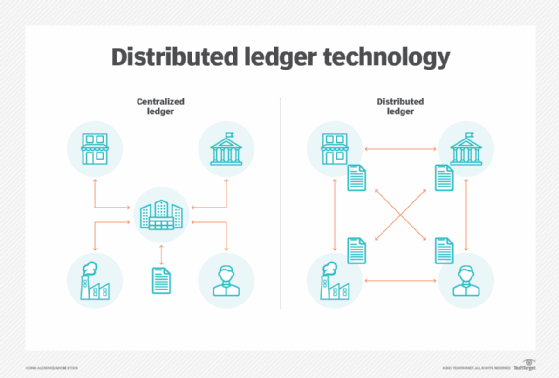What is Hyperledger?
Hyperledger started as a collection of open source projects created to support the development of blockchain-based distributed ledgers. This included frameworks, standards, tools and libraries to build blockchains and related applications. In 2021, Hyperledger Foundation became the official governing body and community for Hyperledger. In 2024, the Linux Foundation, which created Hyperledger in 2015, launched LF Decentralized Trust, which now hosts and owns the Hyperledger projects and a number of other technologies and standards.
Since Hyperledger's creation, the project has had contributions from various industries and organizations, such as American Express, IBM, Intel, Microsoft, Samsung and VMware, and blockchain startups, such as Blockstream and Digital Asset. This collaboration includes banking, supply chain management, internet of things, manufacturing and production-based fields.
Hyperledger acts as a hub for different distributed ledger frameworks and libraries. With this, a business could use one of Hyperledger's frameworks to improve efficiency, performance and transactions in its business processes, for example.
Hyperledger provides the needed infrastructure and standards for developing blockchain systems and applications. Developers can also use Hyperledger-provided tools to create business blockchain projects. Network participants are all known to each other and can participate in consensus-making processes.
Hyperledger-based technology works using the following layers:
- A consensus layer, which makes an agreement on order and confirms if the transactions in a block are correct.
- A smart contract layer, which processes and authorizes transaction requests.
- A communication layer, which manages peer-to-peer message transport.
- An application programming interface (API), which enables other applications to communicate with the blockchain.
- Identity management services, which validate the identities of users and systems.
Notable frameworks: Hyperledger Fabric and Hyperledger Besu
Two notable Hyperledger projects include Hyperledger Fabric and Hyperledger Besu:
Hyperledger Fabric
This is one of the most popular projects in Hyperledger. It is a permissioned blockchain infrastructure used to build blockchain-based products, software and applications. Hyperledger Fabric was made in cooperation with IBM and Digital Asset. It provides a modular architecture that defines roles between nodes, execution of smart contracts and configurable consensus services. Features of Fabric include the use of smart contracts, as well as pluggable Hyperledger Fabric consensus protocols. Fabric also supports different programming languages through the installation of modules. Hyperledger Fabric is used with integration projects that need a distributed ledger.

Hyperledger Besu
This is an open source Ethereum codebase that can run on private permissioned platforms or the Ethereum public network. It features the Ethereum Virtual Machine (EVM), consensus algorithms, user-facing APIs and monitoring. Besu is useful for projects that need interoperability within the Ethereum ecosystem, like decentralized applications, for example.
Other Hyperledger tools and projects
Hyperledger Fabric and Besu are not the only two projects Hyperledger has. Hyperledger offers multiple projects and tools currently active or under incubation -- meaning they require certain exit criteria before being declared active and production-ready. Some of these projects include the following:
- Hyperledger AnonCreds. This ledger-agnostic project specifies anonymous credentials --anoncreds -- a type of verifiable credential.
- Hyperledger Aries. This toolkit enables creating, transmitting and storing digital credentials and decentralized key management.
- Hyperledger Bevel. An accelerator for distributed ledger technology deployment, Bevel enables DLT set-up, deployment and integration with new organizations.
- Hyperledger Cacti. An interoperability and plugin-based framework for connecting and running transactions across multiple different types of ledgers.
- Hyperledger Caliper. This blockchain benchmark tool is used to evaluate the performance of blockchain implementations. However, it doesn't come with predefined standards because blockchain implementations might all require different sets of standards.
- Hyperledger Cello. This project is a blockchain-as-a-service toolkit and operating system used to create, terminate and manage blockchain services.
- Hyperledger FireFly. This is an open source software stack of middleware for Web3 applications.
- Hyperledger Indy. A framework made for decentralized identities, it comes with components, tool sets and libraries. It also includes self-sovereignty, which securely stores all identity-based documentation.
- Hyperledger Iroha. A blockchain framework used to integrate with existing networks, Iroha has a modular design, control-based access, access to many libraries, and asset and identity management. It is used in industries such as financial services, healthcare and education.
- Hyperledger Solang. This is a Solidity compiler -- which is a compiler that translates Solidity code into bytecode for EVMs -- that enables smart contract portability.
Hyperledger has also moved several projects to a dormant, or end-of-life status. Some examples include Avalon, Burrow, Explorer, Quilt and Sawtooth.
History and mission of Hyperledger
The Linux Foundation announced the creation of the Hyperledger Project in 2015, one year before its release. Brian Behlendorf, who was appointed executive director in 2016, stated that the Hyperledger project would never build its own cryptocurrency.
That same year, the project also started to accept proposals for the incubation of codebases and other core element technologies. Two of the initial blockchain framework codebases accepted were Hyperledger Fabric and libconsensus. Later, Intel's distributed ledger, Sawtooth, was incubated.
In 2018, the production-ready Sawtooth 1.0 was added. In 2019, a long-term-support version of Hyperledger Fabric was announced.
In October 2021, Behlendorf passed the executive director position to Daniela Barbosa. That same month, Hyperledger was rebranded to the Hyperledger Foundation to draw a "clearer line between Hyperledger as an organization and individual Hyperledger projects," according to the organization's blog post announcing the change.
Between 2021 and 2022, some early projects like Sawtooth and Avalon were retired. And in 2024, the Hyperledger Foundation became a part of the Linux Foundation Decentralized Trust, which is an open source foundation with the initiative to bring together decentralized technologies.
In 2025, a joint initiative between IBM Research and the Hyperledger community created a set of enhancements to Hyperledger Fabric known as Fabric-X.
Hyperledger Fabric isn't the only blockchain platform option available. Learn more about Hyperledger Fabric, along with seven other blockchain platforms to consider.







